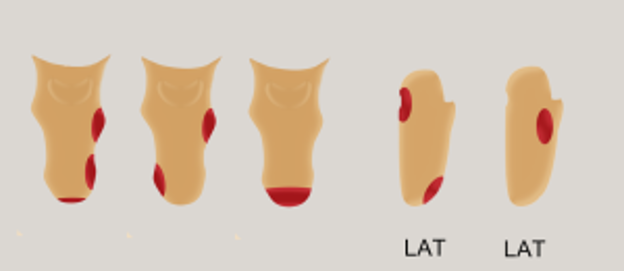Transtibial Socket Pressures
Understanding internal socket pressures is necessary to allow you to correlate areas of discomfort or irritation your patient may be experiencing. This will allow you to increase you patient’s comfort, prevent skin breakdown, and more evenly distribute socket pressure. Both in the real world and for examination purposes, it is very important to interview your patient. Has the individual had any medical changes recently, diet changes (did they eat a lot of salt the recently), change in activity, and so on.
Let’s say you have amputee that presents with anterior distal redness and you find that the cause of the discoloration due to an excessively flexed socket. Not properly interviewing the patient may cause you to miss some important facts.
This particular patient may have simply changed shoes to a pair with a higher heel height. By answering with “excessive socket flexion” despite being plausible, the answer would be incorrect. So no matter how blatantly obvious the scenario may seem, do yourself a favor and continue to question the patient on recent changes, times of the day the pain presents, and if certain activities cause the discomfort. Please review the following scenarios below.
Numbers relating to socket order, i.e. question 1 relates to socket picture 1.
1. Lateral and distal redness
o Socket too large.
2. Proximal lateral and Distal medial redness:
o Adducted Socket.
o Socket M/L too large.
3. Pt. Bottoming out secondary to:
o Decreased residual limb volume, Pt. not donning appropriate amount of socks, socket initially made too big.
o Lack of distal end contact causing verrucous hyperplasia (caused by greater proximal pressure than distal pressure) Fibular head redness:
o Adequate relief is not made for the fib head.
4. Anterior proximal and Posterior distal redness:
o Insufficient initial socket flexion.
o Shoe change with decreased heel height?
o Heel lever too short, or the heel bumper/cushion too soft.
5. What causes anterior distal tibial pressure?
o A/P to big.
o Post-brim too low.
o Insufficient relief.
o Excessive use of knee extension.
o Heel lever to long.
o Excessive initial socket flexion.

